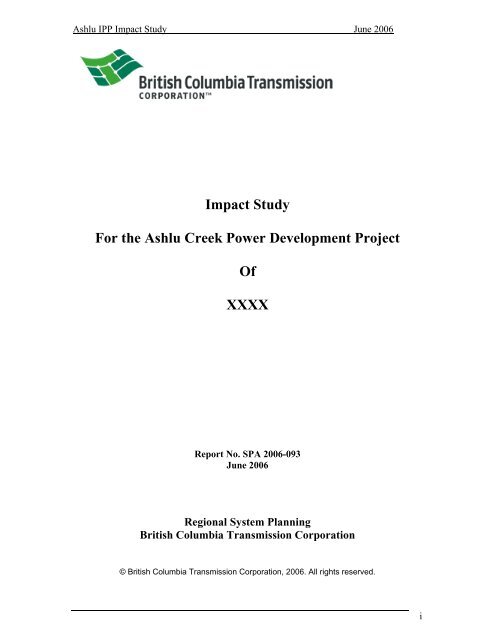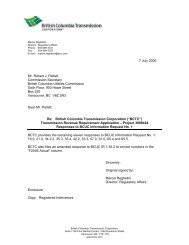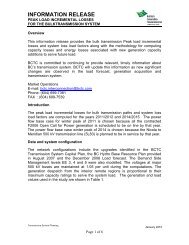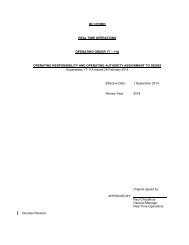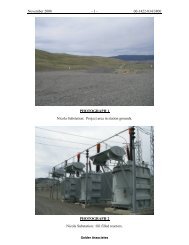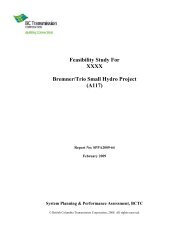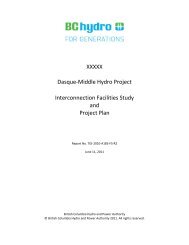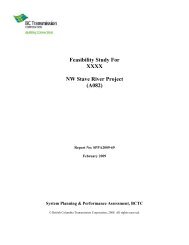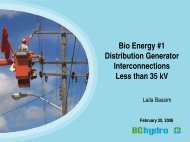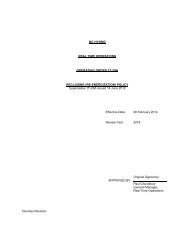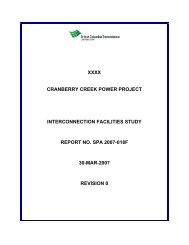Ashlu Creek Impact Study - BC Hydro - Transmission
Ashlu Creek Impact Study - BC Hydro - Transmission
Ashlu Creek Impact Study - BC Hydro - Transmission
You also want an ePaper? Increase the reach of your titles
YUMPU automatically turns print PDFs into web optimized ePapers that Google loves.
<strong>Ashlu</strong> IPP <strong>Impact</strong> <strong>Study</strong> June 2006<br />
<strong>Impact</strong> <strong>Study</strong><br />
For the <strong>Ashlu</strong> <strong>Creek</strong> Power Development Project<br />
Of<br />
XXXX<br />
Report No. SPA 2006-093<br />
June 2006<br />
Regional System Planning<br />
British Columbia <strong>Transmission</strong> Corporation<br />
© British Columbia <strong>Transmission</strong> Corporation, 2006. All rights reserved.<br />
i
<strong>Ashlu</strong> IPP <strong>Impact</strong> <strong>Study</strong> June 2006<br />
DISCLAIMER OF WARRANTY, LIMITATION OF LIABILITY<br />
This report was prepared by <strong>BC</strong>TC solely for the purposes described in this report, and is<br />
based on information available to <strong>BC</strong>TC as of the date of this report. Accordingly, this<br />
report is suitable only for such purposes, and is subject to any changes arising after the<br />
date of this report.<br />
Unless otherwise expressly agreed by <strong>BC</strong>TC, <strong>BC</strong>TC does not represent or warrant the<br />
accuracy, completeness or usefulness of this report, or any information contained in this<br />
report, for use or consideration by any third party, nor does <strong>BC</strong>TC accept any liability out<br />
of reliance by a third party on this report, or any information contained in this report, or<br />
for any errors or omissions in this report. Any use or reliance by third parties is at their<br />
own risk.<br />
________________________________________________________________________________________________________________________________________________<br />
This document contains proprietary information and shall not be reproduced in whole or in part without the prior written consent of <strong>BC</strong>TC<br />
ii
<strong>Ashlu</strong> IPP <strong>Impact</strong> <strong>Study</strong> June 2006<br />
Executive Summary<br />
This report assesses the impact of the interconnection of the proposed 61 MVA<br />
generation and its facilities tapped at <strong>BC</strong>TC’s Cheakamus- Cheekeye (CMS-CKY) 230<br />
kV line 2L12 at 2 km from the CMS end. The report also provides a review and identifies<br />
requirements to connect the proposed generation to the <strong>Transmission</strong> System.<br />
In order to connect the proposed generation and its facilities to the <strong>Transmission</strong> System,<br />
the following conclusions are identified in this impact study:<br />
• The IPP and its facilities will be tapped to the 2L12 of <strong>BC</strong>TC as the Point of<br />
Interconnection (POI) to the <strong>Transmission</strong> System.<br />
• No unacceptable abnormal voltage instability due to <strong>Ashlu</strong> IPP connection has been<br />
observed in the <strong>Transmission</strong> System.<br />
• <strong>Transmission</strong> equipment overload has been observed during heavy summer system<br />
operating conditions. 2L12 has to be upgraded to higher operating temperature from<br />
50 to 63 degree C or higher.<br />
The Interconnection Facilities <strong>Study</strong> report will provide more details with cost estimates<br />
of the system upgrade requirement for connecting this IPP.<br />
________________________________________________________________________________________________________________________________________________<br />
This document contains proprietary information and shall not be reproduced in whole or in part without the prior written consent of <strong>BC</strong>TC<br />
iii
<strong>Ashlu</strong> IPP <strong>Impact</strong> <strong>Study</strong> June 2006<br />
Executive Summary<br />
Table of Content<br />
1.0 Background 1<br />
2.0 Purpose of <strong>Study</strong> 1<br />
3.0 <strong>Study</strong> Assumptions 1<br />
4.0 System Studies 1<br />
4.1 Steady State Power Flow study 1<br />
4.2 Short Circuit study 2<br />
4.3 Power Flow Based First Contingency study 2<br />
4.4 Reliability study 3<br />
4.5 Transient Stability study 3<br />
4.6 Islanding 4<br />
4.7 Black Start Capability 4<br />
5.0 Conclusion and Discussions 4<br />
Appendix<br />
Load flow one-line Diagram for normal and contingency conditions 6<br />
Models for IPP power plant excitation control system 10<br />
Stability swing of rotor angle for 3 phase fault on CKY 230 kV bus 14<br />
Stability swing of bus voltage for 3 phase fault on CKY 230 kV bus 15<br />
Stability swing of line flow for 3 phase fault on CKY 230 kV bus 16<br />
Stability swing of bus frequency for 3 phase fault on CKY 230 kV bus 17<br />
________________________________________________________________________________________________________________________________________________<br />
This document contains proprietary information and shall not be reproduced in whole or in part without the prior written consent of <strong>BC</strong>TC<br />
iv
<strong>Ashlu</strong> IPP <strong>Impact</strong> <strong>Study</strong> June 2006<br />
1.0 Background<br />
XXXX plans to develop the 61 MVA <strong>Ashlu</strong> IPP Project consisting of 3 generator units in the<br />
<strong>Ashlu</strong> power plant site. The maximum power to be injected into the <strong>Transmission</strong> System is<br />
55 MW. The proposed in-service date of this IPP is April 2008.<br />
The proposed Point of Connection (POI) of the IPP and its facilities is 2 km from the CMS end<br />
of the <strong>BC</strong>TC 230 kV line 2L12 (CMS-CKY) . Power generated by the IPP will be transferred<br />
by the 2L12 line via CKY to the <strong>Transmission</strong> System.<br />
2.0 Purpose of <strong>Study</strong><br />
This study assesses the requirements for interconnecting the IPP and its facilities into the<br />
<strong>Transmission</strong> System based on the impact to the regional transmission network. This impact<br />
study identifies system constraints and network upgrades required for the reliable operation of<br />
the inter-connected IPP and the <strong>Transmission</strong> System.<br />
3.0 <strong>Study</strong> Assumptions<br />
The study is carried out based on the model, data and information provided by the IPP for the<br />
inter-connections application process. The 2009 winter peak and 2009 summer peak and light<br />
load base cases are used.<br />
4.0 System Studies<br />
Power flow, short circuit, voltage stability and transient stability studies were carried out to<br />
evaluate the feasibility of the proposed interconnection and to identify the IPP connection<br />
requirements.<br />
4.1 Steady State Pre-outage Power Flows<br />
Pre-outage power flows are prepared to assess the impact of the IPP connection. The<br />
study includes three basic load / generation conditions: the 2009 winter peak, 2009<br />
summer peak and 2009 summer light load conditions. IPP maximum output is assumed<br />
in all case studies.<br />
Results indicate that, under system normal conditions, the thermal loadings of 2L12<br />
will be exceeded in the heavy summer operating conditions. The detailed normal<br />
system conditions are shown in Figures 1 to 3.<br />
Regional System Planning 1
4.2 Short Circuit <strong>Study</strong><br />
Increase in fault levels at remote stations due to <strong>Ashlu</strong> IPP remains within the existing<br />
equipment ratings.<br />
Fault Levels expressed as Thevenin Impedances at point-of-interconnection on 2L12<br />
are:<br />
Present Fault Level (including <strong>Ashlu</strong> IPP):<br />
Z + = R + + jX + = 2.0 + j18.1 ohms<br />
Z - = R - + jX - = 2.1 + j18.5 ohms<br />
Z 0 = R 0 + jX 0 = 1.3 + j20.0 ohms<br />
Present Fault Level (excluding <strong>Ashlu</strong> IPP):<br />
Z + = R + + jX + = 2.34 + j19.5 ohms<br />
Z - = R - + jX - = 2.34 + j19.5 ohms<br />
Z 0 = R 0 + jX 0 = 1.7 + j24.1 ohms<br />
Ultimate Fault Level:<br />
3-phase fault = 5000 MVA<br />
X/R = 10<br />
(assumed)<br />
SLG fault: 12.5 kA rms sym.<br />
The foregoing assumes 1.05 x the base voltage of 230 kV. This is the minimum level<br />
recommended for 230 kV stations for the <strong>BC</strong>TC system and provides adequate<br />
capability for an ultimate 500 – 230 kV tie at Cheekye.<br />
The ultimate duty shall be used for the basic station design such as bus strength and<br />
ground grid and for any major equipment that the owner does not want to replace when<br />
the present fault level increases to the ultimate. No planned date exists for this<br />
increase.<br />
<strong>Ashlu</strong> Generator Step-up Transformer<br />
It is required that this be configured as a conventional generator transformer with a LV<br />
delta to HV grounded wye configuration.<br />
The recommended HV nominal tap for this transformer is 236 kV with +/-2 x 2.5% offload<br />
taps<br />
________________________________________________________________________________________________________________________________________________<br />
This document contains proprietary information and shall not be reproduced in whole or in part without the prior written consent of <strong>BC</strong>TC<br />
2
4.3 Power Flow Based First Contingency <strong>Study</strong><br />
Power flow based single contingency studies do not have any further transmission line<br />
loading problem. There is no voltage violation due to the addition of the <strong>Ashlu</strong> IPP.<br />
There is also no voltage stability issue upon loss of the largest load in this area, or loss<br />
of the <strong>Ashlu</strong> IPP. Summary of load flow study results are shown in Table 1.<br />
Table 1 Steady State Power Flow <strong>Study</strong> Results for <strong>Ashlu</strong> IPP Project<br />
System<br />
Load<br />
Condition<br />
2009 HW<br />
2009 HS<br />
2009 LS<br />
2009 HW<br />
System<br />
configuration<br />
Heavy<br />
winter-<br />
Normal<br />
Heavy<br />
summer-<br />
Normal<br />
Light<br />
summer-<br />
Normal<br />
Heavy<br />
winter- 2L13<br />
outage<br />
MW<br />
Injection<br />
from<br />
IPP<br />
CMS<br />
230<br />
Bus Voltage (in per unit)<br />
CKY<br />
230<br />
SQH<br />
60<br />
MAM<br />
60<br />
Power Flow (MW)<br />
2L13<br />
(CKY-<br />
CYP)<br />
2L12<br />
(CMS-<br />
CKY)<br />
2L9<br />
(CKY-<br />
LYN)<br />
Comment<br />
55 1.010 0.999 1.067 1.069 203 221 230 Fig. 1<br />
55 1.010 1.013 1.071 1.069 209* 134 132 Fig. 2<br />
55 1.048 1.048 1.085 1.080 54 82 84 Fig. 3<br />
55 1.010 1.000 1.068 1.069 203 outage 363 Fig. 4<br />
* 2L12 is overloaded to 106% summer rating. Present line conductor operating temperature<br />
is at 50 deg C. The addition of the <strong>Ashlu</strong> IPP will require that 2L12 be upgraded for a<br />
higher operating temperature.<br />
4.4 Reliability <strong>Study</strong><br />
There is an existing <strong>BC</strong> <strong>Hydro</strong> 173 MVA CMS generating station connected on 2L12<br />
which the <strong>Ashlu</strong> IPP will be tapped on. A reliability assessment of the connection<br />
schemes of employing a disconnect switch (DS) versus a 3 breaker ring (3CB) at the<br />
POI has been performed based on line outage data.<br />
The unavailability of 2L12 for a 3CB scheme is 1.0 hours/year compared to 1.21<br />
hours/year for a DS scheme. Thus, for a small improvement in reliability (0.21<br />
hours/year) the 3-breaker ring configuration is not required from the system reliability<br />
point of view. However, the 2.5 km tap line from the POI to the IPP shall be designed<br />
and maintained to the 2L12 level. Otherwise, reliability of the CMS power plant will be<br />
reduced to an unacceptable level.<br />
________________________________________________________________________________________________________________________________________________<br />
This document contains proprietary information and shall not be reproduced in whole or in part without the prior written consent of <strong>BC</strong>TC<br />
3
4.5 Transient Stability <strong>Study</strong><br />
For transient stability studies, the IPP power plant is modelled in details as shown in<br />
Figures 5-1 to 5-3. Various system operating conditions including the most severe<br />
system operating conditions have been analysed. Detailed control block diagram of the<br />
excitation control system has not yet been available. Typical dynamics model for the<br />
proposed Basler DECS exciter series has been implemented.<br />
Transient stability performance has been identified to be acceptable for the various<br />
system contingencies with normal fault clearing times of 12 and 6 cycles for the 60 and<br />
230 kV network. The existing 2L12 protection is electromechanical and<br />
communication independent. It would need to be replaced since this existing slow<br />
protection is not acceptable. High speed permissive protection scheme will be required.<br />
However, out-of-step protection is required for the IPP as standard generator protective<br />
equipment against unexpected contingencies in the inter-connected IPP and<br />
<strong>Transmission</strong> System. Over-frequency relay for IPP generator protection during<br />
islanding conditions shall also be installed. Summary of system stability study results is<br />
shown in Table 2.<br />
Table 2: Transient stability study results ( 2009 heavy winter case)<br />
Case Outage 3Φ fault Clearing<br />
time<br />
(cycles)<br />
1* 2L13<br />
CKY-CYP<br />
2 CMS 13.8/<br />
230 kV T2<br />
3 CKY 60/<br />
230 kV T5<br />
IPP<br />
max<br />
rotor<br />
swing<br />
CKY230 6 42<br />
deg.<br />
CMS230 6 45<br />
deg.<br />
CKY 66 10 10<br />
deg.<br />
Minimum dynamic voltage level/<br />
Comments for overall system swing<br />
conditions<br />
1.0 pu @ CKY 230 kV bus. /<br />
Acceptable system swings.<br />
0.99 pu @ CKY 230 kV bus. /<br />
Acceptable system swings.<br />
1.01 pu @ CKY 230 kV bus. /<br />
Acceptable system swings.<br />
* Results for Case 1 are shown in Figures 6-1 to 6-4 as typical system swing.<br />
System stability response of delayed clearing of single phase to ground fault is<br />
acceptable. However, delayed clearing of the more severe double phase to ground fault<br />
and three phase fault will cause unacceptable system stability conditions including<br />
voltages, power and frequency oscillations in the area. With the installation of the<br />
grounded Y IPP generator transformer, delayed fault clearing feature in 2L12 for overvoltage<br />
control is no longer required.<br />
________________________________________________________________________________________________________________________________________________<br />
This document contains proprietary information and shall not be reproduced in whole or in part without the prior written consent of <strong>BC</strong>TC<br />
4
4.6 Islanding<br />
IPP will be required to provide over-frequency protection, which will initiate tripping of IPP<br />
entrance breaker should IPP islands connected to 2L12 but line terminal open at CKY and<br />
CMS.<br />
4.7 Black Start Capability<br />
Estimate voltage sag due to transformer energization is about 6%. Black start<br />
capability is not be required from the <strong>BC</strong>TC point-of-view.<br />
5.0 Conclusion and Discussion<br />
In order to interconnect the <strong>Ashlu</strong> IPP generation of 55 MW and its facilities into the<br />
<strong>Transmission</strong> System at <strong>BC</strong>TC’s 2L12 near the CMS Substation, this impact study has<br />
identified the following issues and requirements:<br />
• <strong>Transmission</strong> equipment overload has been observed during heavy summer system<br />
operating conditions. 2L12 has to be upgraded to higher operating temperature from 50<br />
to 63 degree C or higher.<br />
• No equipment overload or voltage violation has been observed under the normal and<br />
contingency conditions after 2L12 is upgraded.<br />
• No adverse transient stability impact on the <strong>Transmission</strong> System has been observed for<br />
the normal types of system disturbances.<br />
• The Basler DECS exciter proposed by the IPP is acceptable for reliable operation of the<br />
inter-connected <strong>BC</strong> <strong>Hydro</strong> and IPP power systems.<br />
• There will be no voltage stability concern for this IPP interconnection.<br />
• Three breaker ring configuration at the POI for connecting the <strong>Ashlu</strong> IPP is not<br />
required. In this particular instance, a tap line with disconnect switch connection<br />
scheme is permissible from the system reliability point of view.<br />
This impact study of the feasibility and requirements for <strong>Ashlu</strong> IPP connection is based on the<br />
best available data. Detailed system study with actual data can be performed as required in the<br />
later stage.<br />
Further information on system upgrade requirement and cost estimates will be provided in the<br />
Facilities <strong>Study</strong> report.<br />
________________________________________________________________________________________________________________________________________________<br />
This document contains proprietary information and shall not be reproduced in whole or in part without the prior written consent of <strong>BC</strong>TC<br />
5
Appendix :-Figs 1 to 4 Power Flow Diagram of <strong>BC</strong>TC/ <strong>BC</strong>H system.<br />
Fig. 1 2009 Heavy winter case.<br />
Regional System Planning 6
<strong>Ashlu</strong> IPP <strong>Impact</strong> <strong>Study</strong> June 2006<br />
Fig. 2 2009 Heavy summer case --- 2L12 (CMS- CKY) overloaded to 106%.<br />
________________________________________________________________________________________________________________________________________________<br />
This document contains proprietary information and shall not be reproduced in whole or in part without the prior written consent of <strong>BC</strong>TC<br />
7
<strong>Ashlu</strong> IPP <strong>Impact</strong> <strong>Study</strong> June 2006<br />
Fig. 3 2009 Light summer case.<br />
________________________________________________________________________________________________________________________________________________<br />
This document contains proprietary information and shall not be reproduced in whole or in part without the prior written consent of <strong>BC</strong>TC<br />
8
<strong>Ashlu</strong> IPP <strong>Impact</strong> <strong>Study</strong> June 2006<br />
Fig. 4 2009 Heavy winter case with 2L13 out of service.<br />
________________________________________________________________________________________________________________________________________________<br />
This document contains proprietary information and shall not be reproduced in whole or in part without the prior written consent of <strong>BC</strong>TC<br />
9
GENSAL<br />
Salient Pole Generator Model<br />
This model is located at system bus #__ASU IPP_ IBUS.<br />
Machine #___80005___ I.<br />
This model uses CONs starting with #___________ J.<br />
and STATEs starting with # ___________ K.<br />
The machine MVA base is ____18.5_______for each of ____3___ units =<br />
___18.5___MBASE.<br />
ZSORCE for this machine is ____0.0______ + j ___0.12___ on the above MBASE.<br />
CONs # Value Description STATEs # Description<br />
J 5.5 T’ do (>0) (Seconds) K E’ q<br />
J + 1 0.03 T’’ do (>0) (Seconds) K + 1 ψkd<br />
J + 2 0.17 T’’ qo (>0) (Seconds) K + 2 ψ’’ q<br />
J + 3 1.67 Inertia H K + 3 Δ Speed ( p.u. )<br />
J + 4 1.0 Speed Damping D K + 4 Angle ( radians )<br />
J + 5 1.24 X d<br />
J + 6 0.67 X q<br />
J + 7 0.2 X’ d<br />
J + 8 0.12 X’’ d = X’’ q<br />
J + 9 0.08 X ι<br />
J + 10 0.154 S(1.0)<br />
J + 11 0.447 S(1.2)<br />
X d , X q , X’ d , X’’ d , X’’ q , X ι , H and D are in p.u., machine MVA base.<br />
X’’ q must be equal to X’’ d<br />
IBUS, ‘GENSAL’, I, T’ do , T’’ do , T’’ qo , H, D, X d , X q , X’ d , X’’ d , X ι , S(1.0), S(1.2)/<br />
Fig. 5-1 <strong>Ashlu</strong> IPP power plant excitation control system model.<br />
Regional System Planning 10
ESAC8B<br />
Basler DECS<br />
This model is located at system bus machine# <strong>Ashlu</strong>-IPP G1/ G2/ G3 IBUS<br />
CONs # Value Description<br />
J 0.0 TR (sec)<br />
J+1 170. KP<br />
J+2 130. KI<br />
J+3 60. KD<br />
J+4 0.03 TD (sec)<br />
J+5 1.0 KA<br />
J+6 0.0 TA<br />
J+7 10.0 V RMAX or zero<br />
J+8 0.0<br />
V RMIN<br />
J+9 1.0 TE > 0 (sec)<br />
J+10 1.0 KE or zero<br />
J+11 3.38 E1<br />
J+12 1.36 SE(E1)<br />
J+13 4.5 E2<br />
J+14 1.5 SE(E2)<br />
STATEs # Description<br />
K Sensed VT<br />
K+1 Integral controller<br />
K+2 Derivative controller<br />
K+3 Voltage regulator<br />
K+4 Exciter output, EFD<br />
IBUS, ’ESAC8B’, I, TR, KP, KI, KD, TD, KA, TA, V RMAX, V RMIN, TE, KE, E1, SE(E1), E2, SE(E2)/<br />
Fig. 5-2 <strong>Ashlu</strong> IPP power plant excitation control system model (cont’d)<br />
________________________________________________________________________________________________________________________________________________<br />
This document contains proprietary information and shall not be reproduced in whole or in part without the prior written consent of <strong>BC</strong>TC<br />
11
PSS/E-29<br />
PSS2A<br />
IEEE Dual Input Stabilizer Model<br />
This model is located at system bus #__<strong>Ashlu</strong>_IPP_ IBUS.<br />
Machine #___80005____ I.<br />
This model uses CONs starting with #___________ J.<br />
and STATEs starting with # ___________ K.<br />
and VARs starting with # ___________ L.<br />
and ICONs starting with<br />
# ___________ IC.<br />
ICONs # Value Description<br />
IC 2 IC1, First Stabilizer Input Code:<br />
1 p.u. Rotor Speed Deviation<br />
2 p.u. Bus Frequency Deviation<br />
3 p.u. Generator Electrical Power on MBASE base<br />
4 p.u. Generator Accelerating Power<br />
5 p.u. Bus Voltage<br />
6. Derivative Of p.u. Bus Voltage<br />
IC + 1 0 REMBUS1, First Remote Bus Number<br />
IC + 2 3 IC1, First Stabilizer Input Code:<br />
1 p.u. Rotor Speed Deviation<br />
2 p.u. Bus Frequency Deviation<br />
3 p.u. Generator Electrical Power on MBASE base<br />
4 p.u. Generator Accelerating Power<br />
5 p.u. Bus Voltage<br />
6. Derivative Of p.u. Bus Voltage<br />
IC + 3 0 REMBUS2, Second Remote Bus Number<br />
IC + 4 5 M, Ramp Tracking Filter<br />
IC + 5 1 N, Ramp Tracking Filter<br />
CONs # Value Description<br />
J 10. T W1 (>0)<br />
J + 1 10. T W2<br />
J + 2 0. T 6<br />
J + 3 10. T W3 (>0)<br />
J + 4 0. T W4<br />
________________________________________________________________________________________________________________________________________________<br />
This document contains proprietary information and shall not be reproduced in whole or in part without the prior written consent of <strong>BC</strong>TC<br />
12
J + 5 10. T 7<br />
J + 6 2.99 K S2 = T7/2H<br />
J + 7 1. K S3<br />
J + 8 0.5 T 8<br />
J + 9 0.1 T 9 (>0)<br />
J + 10 20.0 K S1<br />
J + 11 0.15 T 1<br />
J + 12 0.025 T 2<br />
J + 13 0.15 T 3<br />
J + 14 0.025 T 4<br />
J + 15 0.1 V STMAX<br />
J + 16 -0.1 V STMIN<br />
Fig. 5-3 <strong>Ashlu</strong> IPP power plant excitation control system model (cont’d).<br />
________________________________________________________________________________________________________________________________________________<br />
This document contains proprietary information and shall not be reproduced in whole or in part without the prior written consent of <strong>BC</strong>TC<br />
13
Fig. 6-1 Stability swing of rotor angle for 3 phase fault on CKY 230 kV bus<br />
Regional System Planning 14
Fig. 6-2 Stability swing of bus voltage for 3 phase fault on CKY 230 kV bus<br />
________________________________________________________________________________________________________________________________________________<br />
This document contains proprietary information and shall not be reproduced in whole or in part without the prior written consent of <strong>BC</strong>TC<br />
15
Fig. 6-3 Stability swing of line flow for 3 phase fault on CKY 230 kV bus<br />
________________________________________________________________________________________________________________________________________________<br />
This document contains proprietary information and shall not be reproduced in whole or in part without the prior written consent of <strong>BC</strong>TC<br />
16
Fig. 6-4 Stability swing of bus frequency for 3 phase fault on CKY 230 kV bus<br />
________________________________________________________________________________________________________________________________________________<br />
This document contains proprietary information and shall not be reproduced in whole or in part without the prior written consent of <strong>BC</strong>TC<br />
17


